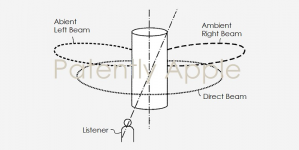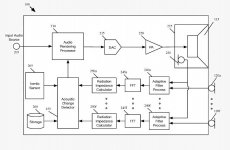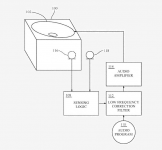Apple just announced their smart speaker called the HomePod. It looks to incorporate some advanced speaker design principles. But there's something that's scratching my head. What the heck is Apple doing with the tweeters???

Originally I thought this is just 7 tweeters in a circular array that does the same thing as the Beolab 90 to provide directivity control. But a closer look, and Phil tells us that the 7 tweeters are actually firing into a common down firing horn.
So what is Apple doing here? How do you even get treble out of a down firing horn that is practically touching the surface the speaker sits on?
Now even if the treble gets out, how can there be any horizontal directivity control when it is from a vertically mounted horn? The only way I can see it work is if the phasing happens within the horn, and it is already reduced into a narrow beam, which is then reflected by the horn to hit the surface at a designated angle, which is then reflected by the surface to our ears.
Any thoughts?

Originally I thought this is just 7 tweeters in a circular array that does the same thing as the Beolab 90 to provide directivity control. But a closer look, and Phil tells us that the 7 tweeters are actually firing into a common down firing horn.
So what is Apple doing here? How do you even get treble out of a down firing horn that is practically touching the surface the speaker sits on?
Now even if the treble gets out, how can there be any horizontal directivity control when it is from a vertically mounted horn? The only way I can see it work is if the phasing happens within the horn, and it is already reduced into a narrow beam, which is then reflected by the horn to hit the surface at a designated angle, which is then reflected by the surface to our ears.
Any thoughts?
Last edited:
Politically correct stuff targeted to the happy few supposedly knowledgeable because economically reliable...
Pass auf!😡
Pass auf!😡
An externally hosted image should be here but it was not working when we last tested it.
Last edited:
What the heck is Apple doing the tweeters?
The tweeters each have their own drive signal, so that the phased array
can have any directional pattern desired. You can be sure that it works well,
since Apple's Tom Holman (Advent, APT, Lucasfilm, THX, USC) designed this.
Yeah, better spend their money in higher quality Apple Music programs instead of freaky HT gadgets like these...
It works, pssss.... For kids...😀

It works, pssss.... For kids...😀
Last edited:
Member
Joined 2009
Paid Member
I think it's pretty darn brilliant. This kind of speaker is the way of the future, it's smart enough to take into consideration the room environment, it's got no WAF issues, and it's easy to use. The traditional stereo is so dead it doesn't even know it yet. Of course Apple has to make something cheap enough for high volume production and as such will have a number of compromises that limits it's appeal to us folk who hang around here. What we're missing is the hi-end version of this approach but the majority of hi-end speaker manufacturers simply don't have the R&D talent to work at this level of technology; have to rely on wood veneer to stay in business. For now.
>>> I think it's pretty darn brilliant.
I do too!
>>> The traditional stereo is so dead it doesn't even know it yet.
I agree, Bigun!
Can anyone help me understand how the tweeter array works? It appears to be seven tweeters firing backwards into a waveguide at the bottom of the speaker - but I'm not sure.
It's also my understanding these are 'fullrange drivers' from this speaker Apple used to sell... in fact, I think the HomePod is essentially this speaker redesigned and repackaged.
Amazon.com: Harman Kardon Soundsticks III 2.1 Channel Multimedia Speaker System with Subwoofer: Electronics
I do too!
>>> The traditional stereo is so dead it doesn't even know it yet.
I agree, Bigun!
Can anyone help me understand how the tweeter array works? It appears to be seven tweeters firing backwards into a waveguide at the bottom of the speaker - but I'm not sure.
It's also my understanding these are 'fullrange drivers' from this speaker Apple used to sell... in fact, I think the HomePod is essentially this speaker redesigned and repackaged.
Amazon.com: Harman Kardon Soundsticks III 2.1 Channel Multimedia Speaker System with Subwoofer: Electronics
Now in stereo, and reports are that the effect is greater than the sum of the parts.
ie 1+1 =3
dave
ie 1+1 =3
dave
how the tweeter array works? It appears to be seven tweeters firing backwards
into a waveguide at the bottom of the speaker.
Each tweeter is individually driven and controlled.
https://static.electronicsweekly.com/wp-content/uploads/2018/02/19134257/apple-homepod-0.jpg
Pictured above is the inside of the tweeter assembly, and “the vented,
horn-loaded tweeter that gives the HomePod its ‘precise’ sound,” says iFixit.
Based on patents filed by Apple, the Homepod possibly has some clever tricks up its sleeve. I have no verification that these all are incorporated in the Homepod. Information taken from patentlyapple.com.
The U.S. Patent Office Publishes Six HomePod and Future Apple Audio Inventions - Patently Apple
1. One patent describes that a microphone array can be used to find nearby reflective surfaces. This information can be used to know where to steer the sound beams.
http://appft.uspto.gov/netacgi/nph-Parser?Sect1=PTO1&Sect2=HITOFF&d=PG01&p=1&u=%2Fnetahtml%2FPTO%2Fsrchnum.html&r=1&f=G&l=50&s1=%2220180352324%22.PGNR.&OS=DN/20180352324&RS=DN/20180352324
2. As it can use beam steering, it can send both a beam of direct sound straight to the listener and beams of delayed and possibly decorrelated sound to side walls, to give a sense of ambience. Similar to single speaker stereo, but better.
In this video there appears to be a microphone inside of the enclosure, suggesting this feature is implemented in the Homepod. YouTube [at 2m 43s]
The U.S. Patent Office Publishes Six HomePod and Future Apple Audio Inventions - Patently Apple
1. One patent describes that a microphone array can be used to find nearby reflective surfaces. This information can be used to know where to steer the sound beams.
http://appft.uspto.gov/netacgi/nph-Parser?Sect1=PTO1&Sect2=HITOFF&d=PG01&p=1&u=%2Fnetahtml%2FPTO%2Fsrchnum.html&r=1&f=G&l=50&s1=%2220180352324%22.PGNR.&OS=DN/20180352324&RS=DN/20180352324
2. As it can use beam steering, it can send both a beam of direct sound straight to the listener and beams of delayed and possibly decorrelated sound to side walls, to give a sense of ambience. Similar to single speaker stereo, but better.
3. Another patent mentions measuring the radiation impedance, which is the information required to know how much room modes are energized. The figure in the patent shows both microphones inside and outside of the enclosure. With this knowledge, a parametric equalizer can be set to counter the booming effect of room modes. It appears to be similar to what Bang & Olufsen does in the Beolab 5.Apple patent said:The system may aim ambient content toward a wall and direct content away from the wall, if the acoustic environment is not in free space.
In this video there appears to be a microphone inside of the enclosure, suggesting this feature is implemented in the Homepod. YouTube [at 2m 43s]
Attachments
Last edited:
Despite being called a DML, that looks a lot like the JBL/Foster 25 or 35mm dome FRs Apple has used in the millions since the 3rd generation iMac.
DIY2000
dave
It's not the same though, but it's close. From having torn both apart, they only similarities are the aluminum used for the tweeter's diaphragm. The sound sticks are more full range. The HomePod sounds bright and brittle with the woofer disconnected.
Looks like HomePod didn't sell according to Tim's expectations since it was discontinued Friday night.
I'd be curious to know if the tweeters could be wired in series/parallel, a crossover designed and built, for both the tweeter array and woofer so one could use a dead HomePod's enclosure and drivers as a passive speaker..?
You wouldn't get custom beam forming sound stuff since each tweeter is driven separately. The HomePod's amplifier board has 7 Analog Devices SSM35158 (one per tweeter). The level of each tweeter is controlled by the logic board based off what the 6 microphone hear. There's a 7th microphone JUST for the woofer to ensure if isn't over driven at higher volumes and to ensure it's bass-ey enough at lower volumes.
Attachments
-
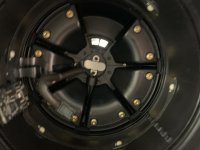 HP Tweeter Light.jpg947.5 KB · Views: 241
HP Tweeter Light.jpg947.5 KB · Views: 241 -
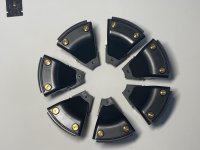 HP Tweeter Slices.jpg673.7 KB · Views: 169
HP Tweeter Slices.jpg673.7 KB · Views: 169 -
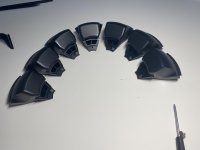 HP Tweeter Slice 2.jpg486.9 KB · Views: 218
HP Tweeter Slice 2.jpg486.9 KB · Views: 218 -
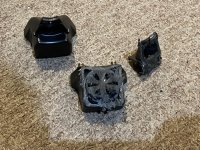 IMG_0853.jpg1.1 MB · Views: 178
IMG_0853.jpg1.1 MB · Views: 178 -
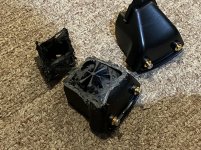 IMG_0852.jpg1.1 MB · Views: 168
IMG_0852.jpg1.1 MB · Views: 168 -
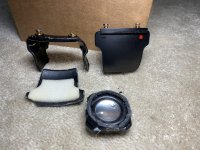 IMG_0855.jpg1,015 KB · Views: 168
IMG_0855.jpg1,015 KB · Views: 168 -
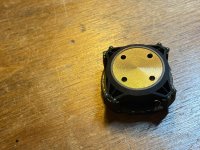 IMG_0908.jpg1,018 KB · Views: 153
IMG_0908.jpg1,018 KB · Views: 153 -
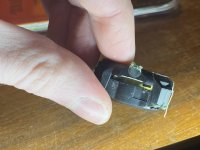 IMG_0910.jpg676.2 KB · Views: 140
IMG_0910.jpg676.2 KB · Views: 140 -
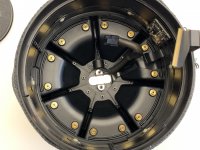 IMG_0683.jpg848.4 KB · Views: 167
IMG_0683.jpg848.4 KB · Views: 167 -
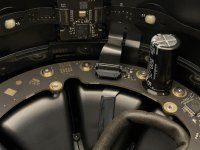 HP Amp board tweeter.jpg881.1 KB · Views: 159
HP Amp board tweeter.jpg881.1 KB · Views: 159
Sure that is possible. There are many threads about designing active (or passive) two way speakers, in which is described how to do it. It is however trivial nor cheap.I'd be curious to know if the tweeters could be wired in series/parallel, a crossover designed and built, for both the tweeter array and woofer so one could use a dead HomePod's enclosure and drivers as a passive speaker..?
- Home
- Loudspeakers
- Multi-Way
- Apple's HomePod, what is this bottom firing horn that provides directivity control?
![19HOWW.chart2[1].jpg](/community/data/attachments/750/750939-663ee8b589cbcf4d3e345ef87fd628ee.jpg?hash=Zj7otYnLz0)
